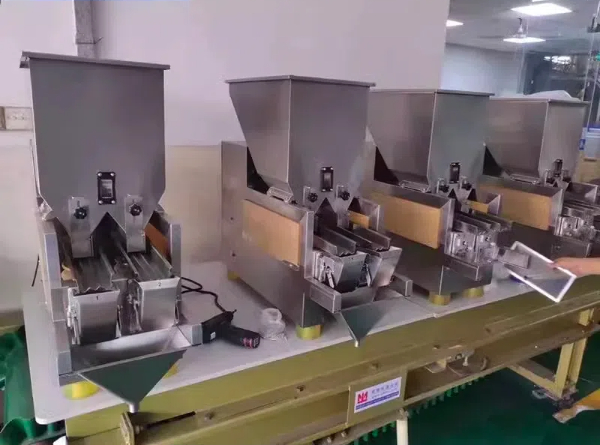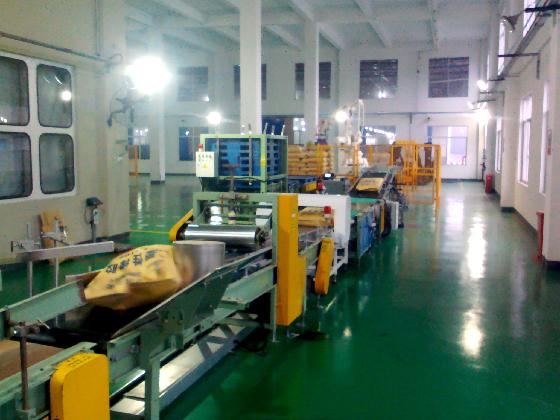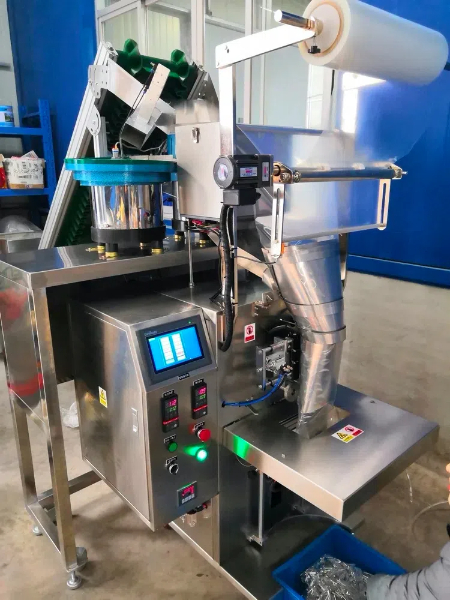
Content Menu
● Introduction
● The Evolution of Dry Food Packaging Technology
>> From Manual to Automated: A Brief History
>> The Rise of Vertical Form Fill Seal Machines
>> Advancements in Packaging Materials and Techniques
● Key Components of Modern Dry Food Packaging Systems
>> Multi-Head Weighing Systems
>> Vertical Form Fill Seal Machines: The Heart of Packaging Operations
>> Automated Feeding and Conveying Systems
>> Quality Control and Inspection Equipment
● Innovations Driving the Future of Dry Food Packaging
>> Industry 4.0 and Smart Packaging Solutions
>> Sustainable Packaging Initiatives
>> Flexible Packaging for Dry Foods
● Challenges and Opportunities in the Dry Food Packaging Industry
>> Meeting Diverse Product Requirements
>> Balancing Speed and Accuracy
>> Addressing Food Safety Concerns
● The Global Impact of Dry Food Packing Machine Factories
>> Enhancing Food Security and Distribution
>> Supporting the Growth of Local Food Industries
>> Driving Innovation in Packaging Design
● Choosing the Right Dry Food Packaging Equipment
>> Assessing Your Production Needs
>> Evaluating Machine Flexibility and Scalability
>> Considering Total Cost of Ownership
● The Future of Dry Food Packing Machine Factories
>> Embracing Artificial Intelligence and Machine Learning
>> Advancing Towards Fully Automated Packaging Lines
>> Developing Eco-Friendly Packaging Solutions
● Conclusion
● Frequently Asked Questions
>> 1. What are the main types of machines used in dry food packaging?
>> 2. How do dry food packing machines ensure food safety?
>> 3. What factors should be considered when choosing a dry food packaging machine?
>> 4. How are dry food packing machine factories addressing sustainability concerns?
>> 5. What are the latest trends in dry food packaging technology?
Introduction
In today's fast-paced food industry, efficient and reliable packaging solutions are crucial for success. Dry food packing machine factories play a pivotal role in meeting the growing demands of food manufacturers worldwide. These factories produce state-of-the-art equipment that ensures the safe, hygienic, and efficient packaging of a wide range of dry food products, from grains and cereals to nuts and snacks. In this comprehensive guide, we'll explore the world of dry food packing machine factories, their innovative technologies, and the impact they have on the global food packaging landscape.
The Evolution of Dry Food Packaging Technology
From Manual to Automated: A Brief History
The journey of dry food packaging has come a long way from manual processes to highly automated systems. In the early days, packaging was a labor-intensive task, prone to inconsistencies and contamination. As the demand for packaged foods grew, so did the need for more efficient and hygienic packaging methods. This led to the development of the first automated packaging machines in the mid-20th century.
The Rise of Vertical Form Fill Seal Machines
One of the most significant innovations in dry food packaging has been the introduction of vertical form fill seal machines (VFFS). These versatile machines have revolutionized the industry by combining forming, filling, and sealing operations in a single, continuous process. VFFS machines are now a staple in dry food packing machine factories, offering high-speed production capabilities and excellent packaging quality.
Advancements in Packaging Materials and Techniques
Alongside machinery developments, packaging materials have also evolved significantly. Modern dry food packaging equipment can work with a wide range of materials, including biodegradable and sustainable options. This has led to the creation of more environmentally friendly packaging solutions that still maintain the integrity and freshness of dry food products.
Key Components of Modern Dry Food Packaging Systems
Multi-Head Weighing Systems
Accuracy in product measurement is crucial for dry food packaging. Multi-head weighing systems have become an integral part of packaging lines, ensuring precise portioning and reducing product giveaway. These systems use a combination of weigh buckets to achieve the target weight quickly and accurately, improving overall efficiency and reducing waste.
Vertical Form Fill Seal Machines: The Heart of Packaging Operations
VFFS machines are the workhorses of dry food packing machine factories. These machines form the packaging material into a tube, fill it with the product, and seal it in one continuous motion. The versatility of VFFS machines allows them to handle a wide range of package sizes and styles, from small snack bags to large family-size packages.
Automated Feeding and Conveying Systems
Efficient product handling is essential for maintaining high production speeds. Automated feeding systems ensure a consistent flow of product to the packaging machines, while conveying systems move packaged products smoothly through various stages of the packaging process, including quality control and secondary packaging.
Quality Control and Inspection Equipment
To maintain the highest standards of product quality and safety, dry food packing machine factories integrate advanced quality control and inspection equipment into their packaging lines. This includes metal detectors, X-ray inspection systems, and vision systems that can detect defects or contaminants in both the product and the packaging.

Innovations Driving the Future of Dry Food Packaging
Industry 4.0 and Smart Packaging Solutions
The integration of Industry 4.0 technologies is transforming dry food packing machine factories. Smart packaging solutions incorporate sensors, data analytics, and machine learning to optimize production processes, predict maintenance needs, and improve overall equipment effectiveness (OEE). This results in reduced downtime, increased productivity, and better resource utilization.
Sustainable Packaging Initiatives
As environmental concerns grow, dry food packing machine factories are focusing on developing sustainable packaging solutions. This includes machines capable of handling eco-friendly materials, as well as technologies that reduce energy consumption and minimize waste during the packaging process. Many factories are also exploring ways to create packaging that is easier to recycle or compost.
Flexible Packaging for Dry Foods
The demand for flexible packaging continues to rise in the dry food sector. Dry food packing machine factories are responding by developing equipment that can handle a wide range of flexible packaging formats, including stand-up pouches, flat-bottom bags, and resealable packages. These formats offer benefits such as improved shelf presence, extended shelf life, and enhanced consumer convenience.
Challenges and Opportunities in the Dry Food Packaging Industry
Meeting Diverse Product Requirements
One of the biggest challenges facing dry food packing machine factories is the need to cater to a wide range of products with varying characteristics. From fine powders to large granules, each product type requires specific handling and packaging considerations. Factories are responding by developing modular and customizable packaging solutions that can be easily adapted to different product requirements.
Balancing Speed and Accuracy
As the demand for packaged dry foods continues to grow, there is constant pressure to increase production speeds. However, this must be balanced with the need for accuracy and quality. High-speed packing machines equipped with advanced control systems and precision components are helping factories achieve this balance, ensuring both productivity and product integrity.
Addressing Food Safety Concerns
Food safety is paramount in the dry food packaging industry. Dry food packing machine factories are incorporating hygienic design principles into their equipment, using materials and construction methods that minimize the risk of contamination. Additionally, they are developing machines that are easier to clean and maintain, reducing downtime for sanitation procedures.
The Global Impact of Dry Food Packing Machine Factories
Enhancing Food Security and Distribution
Efficient packaging solutions from dry food packing machine factories play a crucial role in enhancing global food security. By extending the shelf life of dry food products and enabling safe transportation over long distances, these packaging technologies help reduce food waste and improve distribution, particularly in regions with limited access to fresh food.
Supporting the Growth of Local Food Industries
The availability of advanced packaging equipment from dry food packing machine factories has enabled local food producers in many countries to scale up their operations and compete in global markets. This has led to the growth of local food industries, creating jobs and contributing to economic development.
Driving Innovation in Packaging Design
Dry food packing machine factories are at the forefront of packaging innovation. Their continuous research and development efforts lead to new packaging designs that not only protect and preserve food but also enhance the consumer experience. From easy-open features to portion control options, these innovations are shaping the future of food packaging.

Choosing the Right Dry Food Packaging Equipment
Assessing Your Production Needs
When selecting packaging equipment for dry foods, it's essential to carefully assess your production requirements. Consider factors such as:
- Production volume and desired output speed
- Types of products to be packaged
- Required package sizes and formats
- Available floor space
- Budget constraints
Evaluating Machine Flexibility and Scalability
In today's rapidly changing market, flexibility is key. Look for packaging machines that can handle a variety of products and package types. Additionally, consider the scalability of the equipment – can it be easily upgraded or integrated into a larger packaging line as your production needs grow?
Considering Total Cost of Ownership
While the initial purchase price is important, it's crucial to consider the total cost of ownership when investing in dry food packaging equipment. This includes factors such as:
- Energy efficiency
- Maintenance requirements
- Spare parts availability
- Training and support services
- Potential for future upgrades
The Future of Dry Food Packing Machine Factories
Embracing Artificial Intelligence and Machine Learning
The integration of artificial intelligence (AI) and machine learning (ML) technologies is set to revolutionize dry food packing machine factories. These technologies will enable predictive maintenance, real-time quality control, and autonomous optimization of packaging processes, leading to unprecedented levels of efficiency and product quality.
Advancing Towards Fully Automated Packaging Lines
As automation technologies continue to evolve, we can expect to see more fully automated packaging lines in dry food packing machine factories. These lines will integrate seamlessly with warehouse management systems and enterprise resource planning (ERP) software, creating a truly connected and intelligent manufacturing environment.
Developing Eco-Friendly Packaging Solutions
The push towards sustainability will drive further innovations in eco-friendly packaging solutions. Dry food packing machine factories will focus on developing equipment that can work with new, sustainable materials while maintaining high production speeds and package integrity. This may include machines designed for compostable films, paper-based packaging, or even edible packaging materials.
Conclusion
Dry food packing machine factories are at the heart of the food packaging industry, driving innovation and efficiency in the production of packaged dry foods. From vertical form fill seal machines to advanced quality control systems, these factories are constantly evolving to meet the changing needs of food manufacturers and consumers alike. As we look to the future, the integration of smart technologies, sustainable practices, and flexible packaging solutions will continue to shape the landscape of dry food packaging, ensuring that this vital industry remains at the forefront of food technology and safety.

Frequently Asked Questions
1. What are the main types of machines used in dry food packaging?
The main types of machines used in dry food packaging include vertical form fill seal machines (VFFS), multi-head weighing systems, auger fillers, volumetric cup fillers, and horizontal form fill seal machines (HFFS). Each type is suited to different products and packaging requirements.
2. How do dry food packing machines ensure food safety?
Dry food packing machines ensure food safety through several means:
- Hygienic design principles that minimize contamination risks
- Use of food-grade materials in machine construction
- Integration of quality control systems like metal detectors and X-ray inspectors
- Ability to create hermetically sealed packages that protect against external contaminants
- Easy-to-clean designs that facilitate regular sanitation
3. What factors should be considered when choosing a dry food packaging machine?
When choosing a dry food packaging machine, consider:
- The type and characteristics of the product to be packaged
- Required production speed and capacity
- Available floor space
- Desired package types and sizes
- Budget constraints
- Energy efficiency
- Ease of cleaning and maintenance
- Flexibility to handle different products or package formats
- Compatibility with existing equipment or systems
4. How are dry food packing machine factories addressing sustainability concerns?
Dry food packing machine factories are addressing sustainability concerns by:
- Developing machines that can work with eco-friendly packaging materials
- Improving energy efficiency of packaging equipment
- Designing machines that minimize material waste during the packaging process
- Creating packaging solutions that are easier to recycle or compost
- Implementing smart technologies that optimize resource use and reduce overall waste
5. What are the latest trends in dry food packaging technology?
The latest trends in dry food packaging technology include:
- Integration of Industry 4.0 technologies for smart, connected packaging lines- Development of flexible packaging solutions for improved shelf presence and consumer convenience
- Adoption of sustainable packaging materials and processes
- Implementation of advanced quality control and traceability systems
- Use of AI and machine learning for predictive maintenance and process optimization
- Creation of packaging designs that enhance product freshness and extend shelf life












